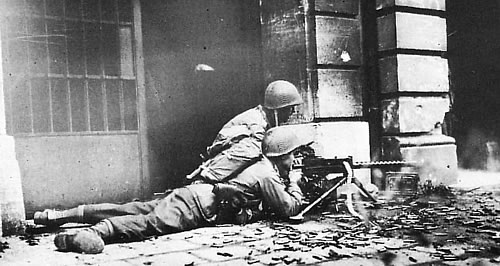"Taking
Aachen" |
 |
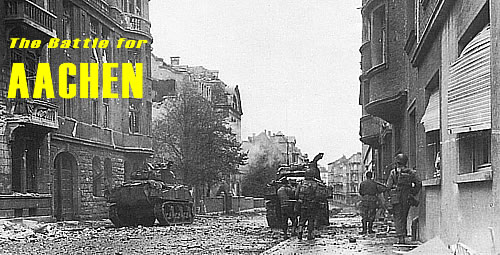
Before the war, Aachen was home to some 165,000 Germans, but in October 1944 the city lay in ruins from repeated bombardment, and less than 20,000 civilians still lived there, defended by 5,000 troops. U.S. command decided to take a page from Germany's blitzkrieg tactics: instead of seeing the city as an objective to be overcome, it was obstacle to be bypassed. The assumption was that surrounding the city and cutting it off from support would force its surrender.
The German garrison was reinforced. Consequently, the Aachen defenders became more of a threat than nuisance to the elements of the U.S. Ninth Army forces moving north and south of the town. This forced the American command to reconsider their strategy. Aachen, they concluded, would have to be taken after all — directly. As the American soldiers encircled the city, they pulverized it with aerial and artillery bombardments.
Urban warfare is perhaps the most difficult kind of fighting — block-by-block, building-by-building, floor-by-floor, room-by-room. Defenders can be easily concealed in fortified buildings and debris. They usually know the city well and can fall back to previously designated positions. Control of taller structures or central intersections gives the defender a significant advantage in tracking the enemy and impeding his progress. Control of the sewer system enables defenders to come up behind their foe.
In the thickest of the fighting were the 2nd and 3rd Battalions of the 26th Infantry Regiment, 1st Infantry Division, supported by the 745th Tank Battalion. They attacked from the southern suburbs, with the 30th Infantry Division moving into the city from the north. But resistance was fierce; in a matter of days the 30th Infantry Division sustained more than 2,000 casualties. Elements of the 29th Infantry Division had to be called in for help. When the last remaining defenders surrendered on Oct 21, the Germans had lost over 5,000 casualties and 5,600 prisoners. U.S. losses were put at 5,000 killed, wounded or missing. In spite of more than 170 tons of bombs and nearly 10,000 rounds of artillery shells fired into the city, the great catherdral that housed the tomb of Emperor Charlemagne emerged intact. "Taking
Aachen"
|
 |
 |
 |
 |
 |
 |
 |
 |
 |
 |
 |
 |
|
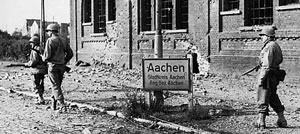 Adolf
Hitler and the defenders of Aachen, made up of elements of the 3rd Panzer Division
and a couple Waffen SS kampfgrouppen, had different ideas, however. The
ancient city was hallowed ground for Germany. As the birthplace and site of the
coronation of Charlemagne, Aachen was the home of the Holy Roman Empire, which
was cited by Hitler as the "First" Reich. Thus, as the first major city
on German soil to face invasion of the Allies, Hitler personally directed that
Aachen be held — at all costs.
Adolf
Hitler and the defenders of Aachen, made up of elements of the 3rd Panzer Division
and a couple Waffen SS kampfgrouppen, had different ideas, however. The
ancient city was hallowed ground for Germany. As the birthplace and site of the
coronation of Charlemagne, Aachen was the home of the Holy Roman Empire, which
was cited by Hitler as the "First" Reich. Thus, as the first major city
on German soil to face invasion of the Allies, Hitler personally directed that
Aachen be held — at all costs. 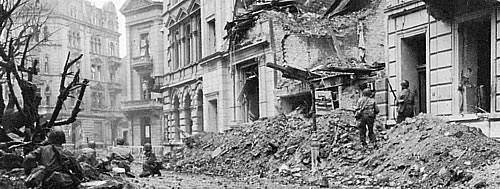
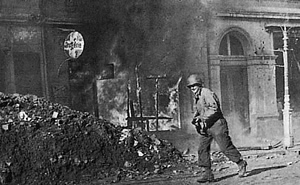 The
attackers are forced to inch their way through deadly mazes of unfamiliar streets
and alleys. Dangerous reconnaissance is necessary to accurately map the defenders'
shifting positions. Communications are vital to coordinating advancing infantry
and armored support. Tanks are effective at dislodging nests of defenders, but
are hampered by debris filled streets and the ever-present threat of handheld
anti-tank weapons. Tires of jeeps and ambulances are shredded by shards of shattered
glass.
The
attackers are forced to inch their way through deadly mazes of unfamiliar streets
and alleys. Dangerous reconnaissance is necessary to accurately map the defenders'
shifting positions. Communications are vital to coordinating advancing infantry
and armored support. Tanks are effective at dislodging nests of defenders, but
are hampered by debris filled streets and the ever-present threat of handheld
anti-tank weapons. Tires of jeeps and ambulances are shredded by shards of shattered
glass. 